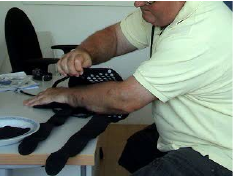A Wearable Neuroprosthesis for the Suppression of Pathological Tremor
By José L. Pons, Eduardo Rocon and Juan A. Gallego
Pathological tremors, which interfere with a patient’s normal life, are currently managed through drug therapy or surgery. A wearable, garment-based neuroprosthesis has been developed as an alternative management of these tremors.
INTRODUCTION
Tremor is defined as a rhythmic, involuntary oscillatory movement of a body part [1]. Although everyone exhibits a certain degree of tremor – the so-called physiological tremor – there are a number of pathologies that lead to very disabling tremors. These pathological tremors constitute the most extended movement disorder, affecting up to 15% of people with age ranging between 50 and 89 years [2]. Moreover, more than 65% of these patients report serious difficulties in performing their activities of daily living (ADL), thus decreasing their quality of life [3].
Tremors are currently managed through pharmacotherapy or surgery, consisting either in stereotactic thalamotomy, or more commonly nowadays, in Deep Brain Stimulation (DBS). Unfortunately, both alternatives have significant drawbacks associated: drugs often induce side effects, and show decreased effectiveness over years of use, [4], while DBS is related to increased risk of intracranial hemorrhage (~4 % of patients), [5] and psychiatric manifestations [6], and the percentage of eligible patients is extremely low [7]. In addition, it is estimated that 25% of this population does not respond to current management alternatives. This article introduces a wearable, garment-based neuroprosthesis conceived as an alternative management of pathological tremors.
THE CONCEPT
Tremor and volitional movement is sensed by means of EMG and Inertial Measurement Units (IMUs). Both sensors are integrated in a wearable sleeve. A cascaded algorithm (first, a Benedict-Bordner filter to track the volitional movement, and then a Kalman filter and a WFLC filter to extract tremor amplitude and frequency respectively) provides all necessary information to drive the neuroprosthesis.
Multi-array electrodes are then used to apply Functional Electrical Stimulation (FES) of upper limb muscles in a two-fold strategy:
- Out-of-phase stimulation of antagonistic muscles, similar to noise cancellation techniques, the so-called active strategy.
- Co-contraction of muscles to modify joint impedance, known as the semi-active strategy.
Figure 1 shows the wearable neuroprosthesis while being dressed on by a patient. It consists of (1) the wearable garment with textile electrodes (see inner part of the sleeve) and (2) a belt, battery operated electronics box.

Figure 1: The wearable neuroprosthesis being worn
by an essential tremor patient prior to clinical trials.
POTENTIAL IMPACT & RESULTS
The system has been clinically tested (n=41) with essential tremor and PD tremor patients. Results show consistent attenuation of severe and mild pathological tremors. An example of these results can be seen in this video.
The neuroprosthesis has been also subject to usability trials during the performance of ADL activities. Patients consistently report a functional improvement. This link shows one of these patients while performing the usability analysis.
Several patents (WO2005/011494, EP1709903) cover various aspects of the system and the methodology for tremor suppression.
If successfully exploited, the wearable tremor suppression neuroprosthesis would potentially help alleviate functional impairments in a fragile population that has no practical management alternative.
For Further Reading
[1] Deuschl, G, Bain, P, Brin, M and Ad Hoc Scientific Committee (1998). “Consensus statement of the Movement Disorder Society on tremor”, Mov Disord 13, 2-23. [2] Wenning, GK, Kiechl, S, Seppi, K, Müller, J, Högl, B, Saletu, M, Rungger, G, Gasperi, A, Willeit and Poewe, W (2005). “Prevalence of movement disorders in men and women aged 50-89 years (Bruneck study cohort): a population-based study”, Lancet Neurol 4, 815-820. [3] Rocon, E, Belda-Lois, JM, Sanchez-Lacuesta, J and Pons, JL (2004). “Pathological tremor management: Modelling, compensatory technology and evaluation”, Techn Disability 16, 3-18. [4] Olanow, CW and Obeso, JA (2000). “Preventing levodopa-induced dyskinesias”, Ann Neurol 47, S167-S176; discussion S176-168 [5] Kleiner-Fisman, G, Herzog, J, Fisman, DN, Tamma, F, Lyons, KE, Pahwa, R, Lang, AE and Deuschl, G (2006). Subthalamic nucleus deep brain stimulation: Summary and meta-analysis of outcomes”, Mov Disord 21, S290-S304. [6] Piasecki, SD and Jefferson, JW (2004). “Psychiatric complications of deep brain stimulation for Parkinson’s disease”, J Clin Psychiatry 65, 845-849. [7] Perlmutter, JS and Mink, JW (2006). “Deep brain stimulation”, Annu Rev Neurosci 29, 229-257.Acknowledgment
This work was supported in part by the European Commission through grant no. 224051.
Contributors
-
J.L. Pons is with Bioengineering Group, CSIC, Arganda del Rey, Madrid, Spain (e-mail: jose.pons@csic.es).
-
E. Rocon and J.A. Gallego are with Bioengineering Group, CSIC, Arganda del Rey, Madrid, Spain.







 Nitish V. Thakor is a Professor of Biomedical Engineering at Johns Hopkins University, Baltimore, USA, as well as the Director of the newly formed institute for neurotechnology, SiNAPSE, at the National University of Singapore.
Nitish V. Thakor is a Professor of Biomedical Engineering at Johns Hopkins University, Baltimore, USA, as well as the Director of the newly formed institute for neurotechnology, SiNAPSE, at the National University of Singapore.  Paolo Bonato, Ph.D., serves as Director of the Motion Analysis Laboratory at Spaulding Rehabilitation Hospital in Boston, MA.
Paolo Bonato, Ph.D., serves as Director of the Motion Analysis Laboratory at Spaulding Rehabilitation Hospital in Boston, MA.  Skyler Ashton Dalley received a B.E. degree in mechanical engineering, in 2007, from Vanderbilt University, Nashville, TN, where he is currently a Ph.D. student in mechanical engineering.
Skyler Ashton Dalley received a B.E. degree in mechanical engineering, in 2007, from Vanderbilt University, Nashville, TN, where he is currently a Ph.D. student in mechanical engineering.  Dan Zondervan holds a B.S in Electrical Engineering from Calvin College, a M.S. in Mechanical Engineering from U.C. Irvine, and is currently pursuing a PhD in Mechanical Engineering.
Dan Zondervan holds a B.S in Electrical Engineering from Calvin College, a M.S. in Mechanical Engineering from U.C. Irvine, and is currently pursuing a PhD in Mechanical Engineering.  David J. Reinkensmeyer received a B.S. degree in electrical engineering from the Massachusetts Institute of Technology in 1988, and M.S. and Ph.D. degrees in electrical engineering...
David J. Reinkensmeyer received a B.S. degree in electrical engineering from the Massachusetts Institute of Technology in 1988, and M.S. and Ph.D. degrees in electrical engineering...